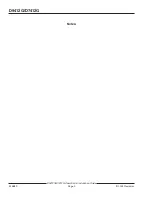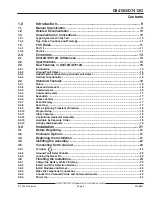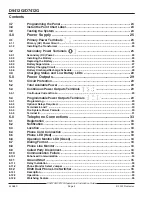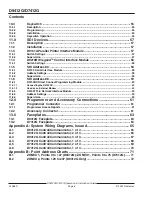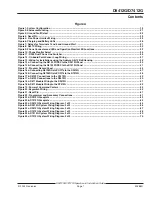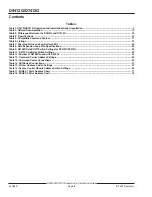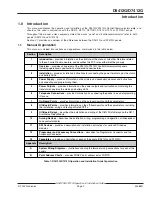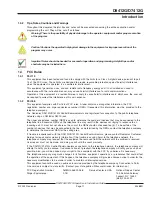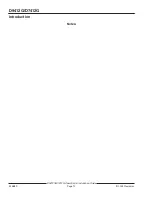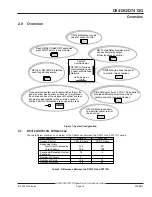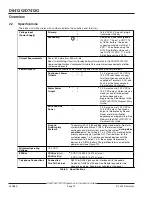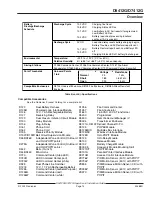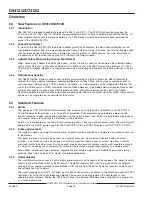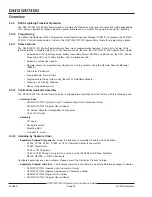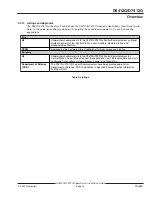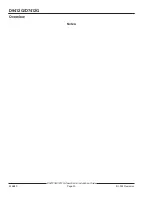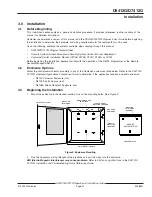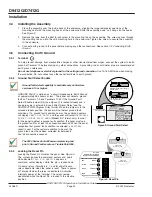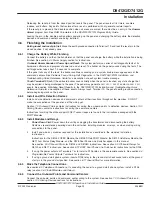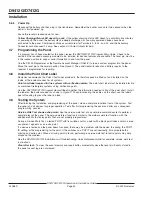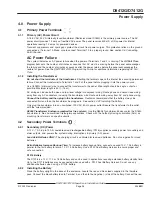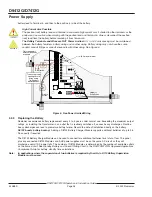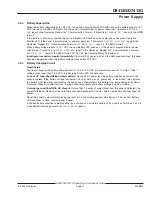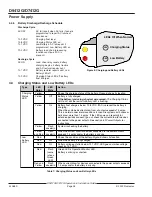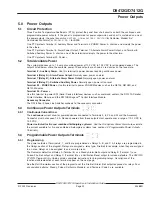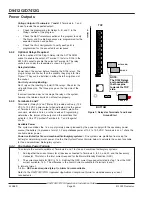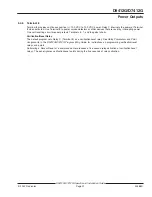
D9412G/D7412G Operation & Installation Guide
43488D
Page 16
© 2002 Radionics
D9412G/D7412G
Overview
2.3
New Features in D9412G/D7412G
2.3.1
Introduction
The D9412G is intended to eventually replace the D9412 and D9112. The D7412G will eventually replace the
D7412 and D7212. The suffix “G” indicates the control/communicator’s ability to detect ground fault conditions. All
other software feature sets that were available in the 9000 Series Control/Communicators have remained the
same in the D9412G/D7412G.
2.3.2
Ground Fault Detect
In order for the D9412G/D7412G to be able to detect ground fault conditions, the Earth Ground Terminal on the
control/communicators had to be electrically-isolated from all other terminals. A Ground Fault Detect Enable switch
(S4) has been added to the panel and is located just under Terminal 10, Earth Ground. For more information on
the operation of this function, see section
3.5.2 Ground Fault Detect Enable.
2.3.3
Added Feature When Using Ground Fault Detect
When Ground Fault Detect is enabled (S4 closed), Points 1-8 can be used for non-powered fire-initiating devices,
such as Heat Detectors, 4-Wire Smoke Detectors, Pull Stations, etc. A D125B Powered Loop Interface or a D129
Dual Class A Interface Module is no longer required when connecting non-powered fire-initiating devices to Points
1-8.
2.3.4
NetCom Functionality
The D6600 NetCom System supports data network communications. NetCom allows the D6600 Receiver to
connect to various network topologies, specifically Ethernet and Token Ring, and to process messages both to
and from most networks using TCP/IP protocols. Connection to a data network can be implemented through the
use of the COM4 and/or a COM1 connection from the D6600 Receiver to the D6680 Network Adapter. Reports from
alarm control panels via phone lines OR Ethernet and Token Ring data networks can be sent to the D6600
Receiver and onto the central station automation software and/or the network printer via LAN or WAN. Alarm control
panels can be monitored on the network for their status.
2.4
Standard Features
2.4.1
Points
The Radionics D9412G Control/Communicator panel provides up to 246 points of protection, and the D7412G
Control/Communicator provides up to 75 points of protection. Point programming parameters determine the
panel’s response to open and shorted conditions on the point’s sensor loop. Points are programmed individually
with several options to custom-fit the protection to the installation.
Points 1 to 8 are located on the circuit board (on-board points). They are standard sensor loops. The remaining off-
board points are POPIT points using D8128D OctoPOPITs, D8125 POPEX Modules and D9127/D8127 POPITs.
2.4.2
Areas and Accounts
The system supports up to eight separate areas. All points can be assigned to a single area or spread out over up
to eight areas.
The panel is armed and disarmed by area, and several areas can be armed and disarmed with one menu
function. A passcode can also be assigned an authority level that allows a user to arm an area from a remote
command center in another area. Assigning each area its own account number creates eight separate accounts
in one panel. Assigning the same account number to different areas groups them together in a single account.
Area options include: exit tone and delay, separate fire and burglary outputs, and multiple opening and closing
windows. Area type can be used to create area interdependencies.
2.4.3
Communicator
The control/communicator uses a built-in digital communicator to send reports to the receiver. The panel transmits
reports in either the Modem IIIa
2
or BFSK format. The D6500 receiver's MPU and line cards must have software
revision 8.00 (or greater) installed to accept Modem IIIa
2
reports from the panel. Cycle the receiver’s down to print
the software revision numbers.
The panel connects to an RJ31X or RJ38X jack for phone line seizure. Connection to the RJ31X complies with FCC
regulations for using the public telephone network. The panel can be programmed to direct reports to four
separate phone numbers. Adding the D928 Dual Phone Line Switcher Module allows connection and supervision
of a second phone line.
Содержание D7412G
Страница 1: ...D9412G D7412G Control Communicators Operation and Installation Guide ...
Страница 2: ...D9412G D7412G Operation Installation Guide 43488D Page 2 2002 Radionics D9412G D7412G Notes ...
Страница 12: ...D9412G D7412G Operation Installation Guide 43488D Page 12 2002 Radionics D9412G D7412G Introduction Notes ...
Страница 20: ...D9412G D7412G Operation Installation Guide 43488D Page 20 2002 Radionics D9412G D7412G Overview Notes ...
Страница 32: ...D9412G D7412G Operation Installation Guide 43488D Page 32 2002 Radionics D9412G D7412G Power Outputs Notes ...
Страница 56: ...D9412G D7412G Operation Installation Guide 43488D Page 56 2002 Radionics D9412G D7412G Arming Devices Notes ...
Страница 60: ...D9412G D7412G Operation Installation Guide 43488D Page 60 2002 Radionics D9412G D7412G SDI Devices Notes ...

